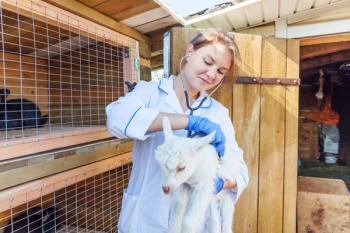
Managing Leptospirosis (Proceedings)
Spirochete with more than 200 serovars. The pathogenic serovars do not replicate outside animal hosts.
Agent
- Spirochete with more than 200 “serovars.” The pathogenic serovars do not replicate outside animal hosts
- Leptospira interrogans
- Serovars: autumnalis, bratislava, canicola, icterohaemorrhagiae, pomona
- Leptospira kirshneri
- Serovar: gryppotyphosa
- Leptospira borgpetersenii
- Serovar: hardjo
- Specific serovars are “hosted-adapted” to certain reservoir species and generally do not cause disease in those hosts, e.g.:
- L. interrogans bratislava pigs, rats, small mammals
- L. interrogans canicola dogs
- L. interrogans icterohaemorrhagiae rats
- L. kirschneri grippotyphosa voles, raccoons, small mammals
Epidemiology
- Animals are critical to the maintenance of pathogenic leptospires in a given area.
- Leptospires can persist in the renal tubules without causing disease, and can be excreted in the urine for prolonged periods of time.
- Leptospires evade immune responses while sequestered in renal tubules.
- Prevalence in dogs is increasing since 1983
- Risk factors
- Adult (4 – 7 years) intact male dogs
- Herding, working dogs, and hounds
- Enzootic worldwide
- Tropical and semitropical areas
- Alkaline soil
- Leptospires can survive in moist environments for months, but are killed by freezing
- Seasonality
- Summer or fall
- Rainy periods
Transmission
- Leptospires are eliminated by urine and enter the body through abraded skin and intact mucous membranes
- In dogs, leptospira concentrates in the liver and kidneys
- Clinical signs – 7 days post-exposure
- May clear the infection in 2 – 3 weeks
- May develop chronic renal failure or chronic active hepatitis
- In cats, infections are usually subclinical
- Cats can shed leptospira in the environment
Clinical Signs
- Many, if not most, Leptospira infections in dogs are subclinical
- L. interrogans icterohaemorrhagiae: Hepatic disease and hemorrhage occur mostly with (may also have sub-acute uremia)
- L. interrogans bratislava: Renal disease predominates with (liver changes also can be present)
- L. interrogans pomona: Renal and liver disease mostly
- L. kirschneri grippotyphosa: Renal and liver disease mostly
- L. interrogans canicola: Mostly renal changes
- Experimental infection
- L. interrogans pomona and L. interrogans bratislava causes hemorrhagic and inflammatory lesions in lungs kidneys and liver.
- Signs
- Fever
- Uveitis
- Vomiting, diarrhea
- Renal failure
- Liver failure
- Jaundice
- Muscle pain
Laboratory Abnormalities
- CBC
- Leukopenia (acute)
- Leukocytosis (subacute)
- Thrombocytopenia
- Renal failure
- Increased BUN and creatinine
- Cillindruria
- Pyuria
- Hematuria
- Liver disease
- Increased activity of ALT and Alkaline phosphatase
- ALP is usually higher than ALT
- Increased bilirubin
- Interstitial lung disease
Diagnosis
- Clinical Signs + Serology
- Detection of antibodies
- Antibodies from active infection, previous infection or vaccination
- Active infection
- MAT titer > 3200
- 4 fold increase in titer over 2 – 4 weeks
- Positive IgM ELISA
- Titers can be negative in acute infection
- Vaccine may induce antibodies against L. interrogans automnalis
- Demonstration of the organism
- Dark-field or phase-contrast microscopy in the urine
- Intermittent shedding leads to false-negative
- Culture
- Before antibiotics
- Place immediately in transport media
- To the laboratory ASAP
- Pre-treatment with furosemide may increase yield
- PCR (urine)
- Early positive
- Very sensitive
- May be positive for years after recovery
- 8% of dogs (regardless of health status) shed pathogenic leptospir
- Serology is a poor predictor of leptospiruria
- 22% sensitivity, 79% specificity
Therapy
- Fluid therapy
- Maintain hydration
- Preserve renal function
- Antibiotics
- Ampicillin or penicillin G
- Initially IV
- Doxycycline for 2 weeks after penicillin to eliminate the carrier phase
- Decreases shedding, but may not eliminate it
Prevention
- All serovars can potentially infect humans
- Wear gloves
- Vaccines
- Can reduce severity of the disease but do not eliminate the carrier state
- May not protect against all serovars
- Not necessary in geographic areas with low/absent risk
- The most reactogenic vaccines for the dog
- The duration of immunity is short (£ 1 year).
- If risk of Leptospira disease is high
- Vaccines need to be given much more often than they are currently given
- 4-way lepto product
- 12 weeks, 15 weeks, 6 months, 1 year
- Then every 6 to 9 months if it remains at high risk
- Relative efficacy
- L. interrogans canicola: £ 75%
- L. kirshnerii grippotyphosa: £ 60%
- L. interrogans icterohaemorrhagiae: £ 90%
- L. interrogans pomoma: £ 60%
Public health
- Leptospirosis can occur as either sporadic cases or in epidemics
- Infection occurs through mucosal contact with water or soil contaminated with the urine of infected animals
- Risk occupations
- Veterinarians, farmers and abattoir workers
- Recreational activities in water
References
Adin CA & Cowgill LD. Treatment and outcome of dogs with leptsopirosis: 36 cases. JAVMA 216():371-5, 2000.
Bal AE et al. Detection of leptropires in urine by PCR for early diagnosis of leptospirosis. J Clin Microbiol 32(8):1894-8, 1994
Barr, S.C. et al. Serologic responses of dogs given a comme rcial vaccine against Leptospira interrogans serovar pomona and Leptospira kirschn eri serovar grippotyphosa. AJVR. 66:1780-1874. 2005
Birnbaum N et al. Naturally acquired leptospirosis in 36 dogs: serological and clinicopathological features. JSAP 39(5):231-6, 1998
Brown CA et al. Leptospira interrogans serovar grippotyphosa infection in dogs. JAVMA 209(7):1265-7, 1995.
Forrest, L.J. et al. Sonographic renal finding s in 20 dog s with leptospirosis. Vet. Radiol. Ultrasound 39:337-340. 1998
Greenlee , J.J. et al. Clinical and pathologic comparison of acute leptospirosis in dogs caused by two strains of Leptospira kirschneri serovar grippotyphosa. AJVR. 65:1100-1107. 2004
Greenlee JJ. Experimental canine leptospirosis caused by Leptsopira interrogans serovars pomona or bratislava. AJVR 66(10):1816-22, 2005
Harkin KR & Gartrell CL. Canine leptospirosis in New Jersey and Michigan: 17 cases (1990-1995). JAAHA 32(6):495-501, 1996.
Harkin, K.R. et al. Clinical application of a polymerase chain reaction assay for diagnosis of leptospirosis in dogs. JAVMA. 222:1224-1229. 2003
Harkin, K.R. et al. Comparison of polymerase chain reaction assay, bacteriologic culture, and serologic testing in assessment of prevalence of urinary shedding of leptospires in dogs. JAVMA. 222:1230-1233. 2003
Levett, P.N. Leptospirosis. Clin. Microbiol. Rev. 14:296-326. 2001
Syjes J. et al 2010 ACVIM Small Animal Consensus Statement on Leptospirosis: Diagnosis, Epidemiology, Treatment, and Prevention. J Vet Intern Med. 25:1-13, 2011.
Ward, M.P. et al. Evaluation of environmental risk factors for leptospirosis in dogs: 36 cases (1997-2002). JAVMA. 225:72-77. 2004
Ward, M.P. et al. Prevalence of and risk factors for leptospirosis among dogs in the United States and Canada: 677 cases (1970-1998). JAVMA. 220:53-58. 2002
Ward, M.P. et al. Serovar-specific prevalence and risk factors for leptospirosis among dogs: 90 cases (1997- 2002). J.VMA. 224:1958-1963. 2004
Newsletter
From exam room tips to practice management insights, get trusted veterinary news delivered straight to your inbox—subscribe to dvm360.




